First impressions truly matter, and your hallway is often the initial glimpse visitors get of your home’s personality. Yet these transitional spaces frequently recieve less design attention than they deserve, despite being constantly traveled through several times daily.
A thoughtfully designed entrance doesn’t just welcome guests—it sets the tone for your entire living space while solving practical everyday challenges.
According to a 2023 survey by the National Association of Realtors, homes with well-designed entryways can command up to 7% higher selling prices, with buyers citing “positive first impressions” as a key factor in their purchasing decisions.
Whether your hallway is narrow, wide, small, or sprawling, these 20 ideas combine style and function to transform this often-neglected area into a standout feature of your home.
Understanding Your Hallway’s Potential
Before diving into specific design elements, take time to evaluate what you’re working with. Is your hallway a narrow corridor or a generous entrance?
Does it suffer from limited natural light or awkward angles? According to interior designer Nina Campbell, “The hallway sets the design grammar for the entire home—it’s worth investing time understanding its unique challenges.”
A well-conceived hallway serves multiple functions:
- Creating a welcoming first impression
- Providing practical storage for everyday items
- Establishing a transitional space between outdoors and living areas
- Reflecting your home’s overall aesthetic
Interior psychologist Emma Howarth notes, “Entrances affect both residents and visitors on a subconscious level. A cluttered, dark hallway creates immediate stress, while an organized, light-filled entrance instantly soothes and welcomes.” With that understanding, let’s explore specific strategies to maximize your hallway’s potential.
1. Thoughtful Color Palettes That Transform Spaces
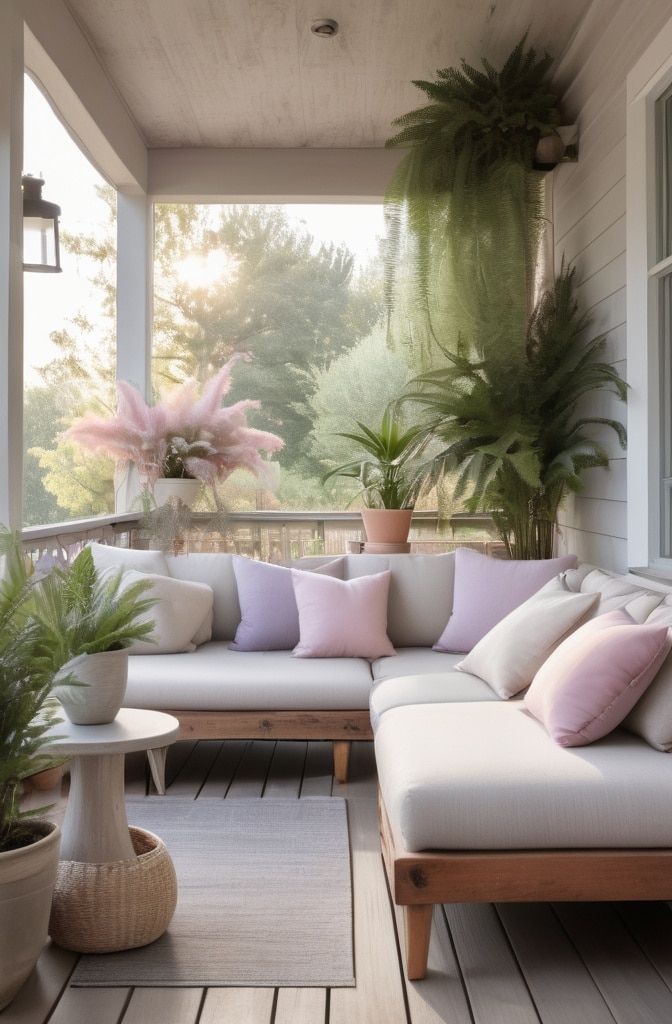
The right color scheme can visually expand tight spaces or add warmth to cavernous ones. For narrow hallways, designers overwhelmingly recommend light, reflective shades like soft greys, pale blues, or warm beiges to create an illusion of spaciousness.
“Light bounces differently in transitional spaces than in rooms where you linger,” explains color specialist Maria Thompson. “In hallways, I often recommend slightly warmer tones than you might choose for living spaces, as they create a sense of movement and welcome.”
In wider hallways, don’t shy from bolder choices. Deep navy, forest green, or even carefully applied charcoal can add sophistication and intimate feel. The key is balance—consider using darker shades on one accent wall while keeping other surfaces lighter.
A particularly effective technique involves using color to draw the eye forward. Designer Tom Howley suggests: “Painting the end wall of a hallway in a slightly deeper shade than the side walls creates depth and interest, making the space feel purposeful rather than simply transitional.”
Before & After Example: The Evans family transformed their narrow 1930s entrance hallway by replacing dark wood paneling with vertical beadboard painted in Farrow & Ball’s “Borrowed Light.” The soft blue-grey tone visually raised their 8-foot ceilings while brightening the space significantly. Combined with white trim, the hallway now feels twice as wide without structural changes.
2. Statement Lighting That Creates Atmosphere
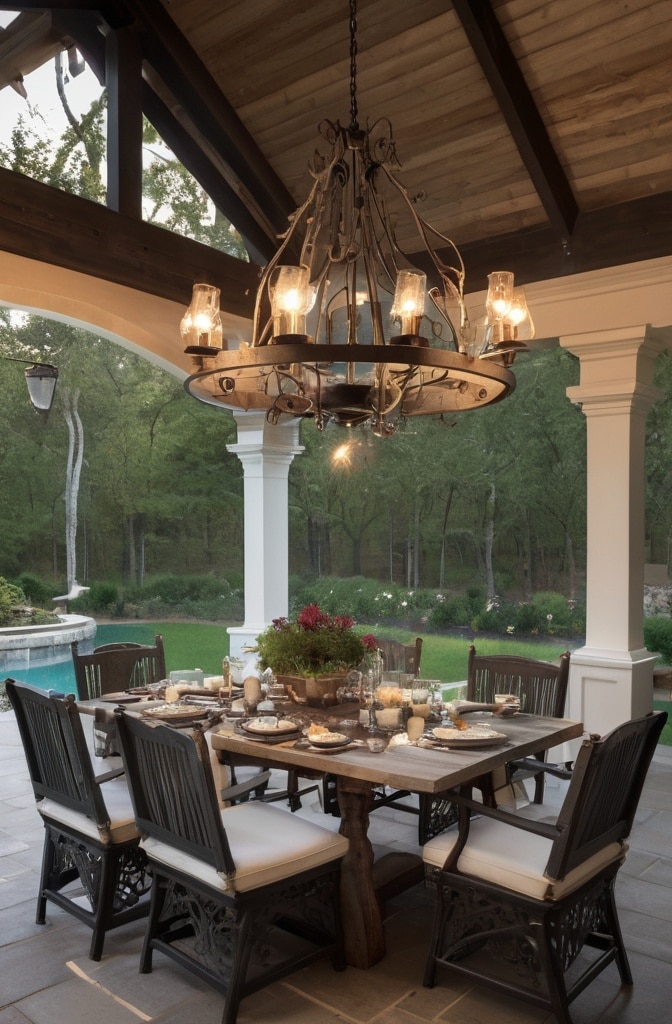
Lighting in hallways needs to work harder than almost anywhere else in the home, serving both practical and atmospheric purposes. Experts recommend a layered approach combining ambient, task, and accent lighting.
For primary illumination, consider:
- Flush-mount fixtures for lower ceilings (under 8 feet)
- Semi-flush designs for medium heights (8-9 feet)
- Pendant lights or chandeliers for generous ceiling heights (above 9 feet)
“The height of your ceiling isnt just a practical consideration—it influences the entire mood,” notes lighting designer Sarah Bernhard. “A Victorian-inspired hallway with high ceilings might call for a dramatic chandelier, while contemporary spaces often benefit from the clean lines of modern pendants or recessed lighting.”
Don’t overlook the power of secondary lighting. Wall sconces placed at intervals create rhythm and prevent the “tunnel effect” in long corridors. For narrow hallways, upward-facing sconces direct light toward the ceiling, making the space feel larger.
Smart lighting solutions have revolutionized hallway design. Motion sensors ensure you’re never fumbling for switches when entering with armfuls of groceries, while dimmable options allow you to adjust brightness throughout the day or set welcoming scenes for guests.
3. Mirror Placement Techniques for Visual Expansion
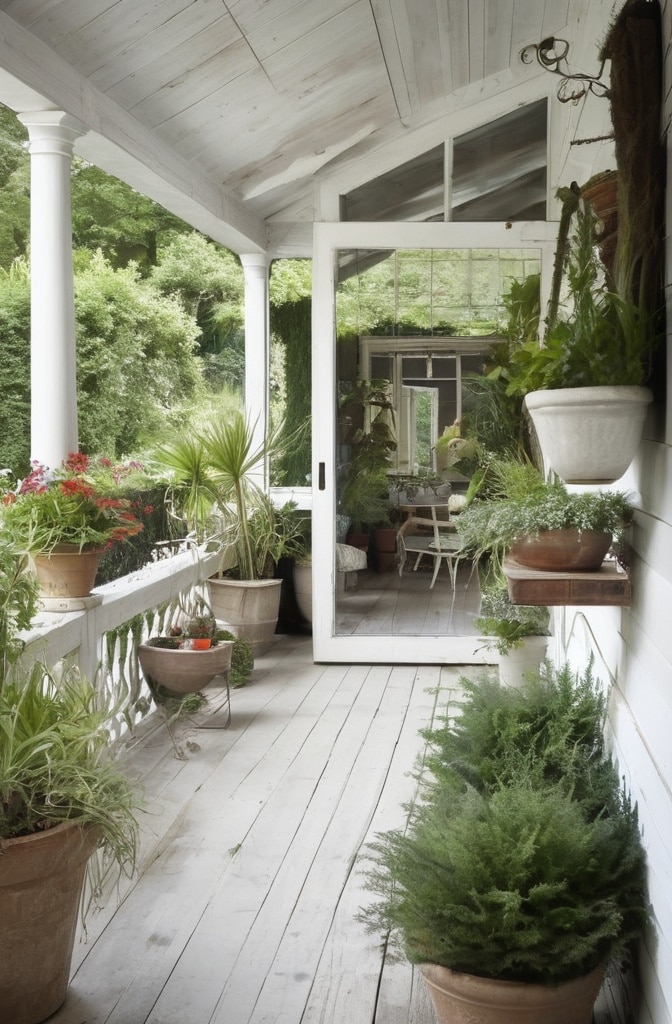
Few design elements work harder in hallways than mirrors, which simultaneously amplify light, create visual space, and offer practical functionality. The key lies in strategic placement.
“Position mirrors where they’ll reflect either natural light from doors or windows, or the most attractive views from your hallway,” advises interior stylist Jessica Graham. “A mirror facing a plain wall wastes its potential.”
For maximum impact in narrow spaces, consider:
- A full-length mirror at the end of the hallway to create an illusion of doubled length
- A series of smaller mirrors on one side to bounce light across the space
- An oversized mirror above a console table to serve as both functional feature and focal point
The frame style significantly impacts the overall effect. Ornate vintage frames add character and traditional charm, while frameless or minimally framed contemporary mirrors maintain clean lines and maximize the reflective surface.
According to a study in Environmental Psychology, spaces with strategically placed mirrors are perceived as up to 25% larger than identical spaces without mirrors. For optimal effect, position your main hallway mirror at eye level (typically 57-65 inches from the floor to the center), allowing both practical use and maximum light reflection.
4. Textile Magic: Rugs as Anchoring Elements

A well-chosen hallway rug does far more than protect flooring—it defines the space, adds warmth, and absorbs sound. Given the high-traffic nature of entryways, material selection is crucial.
Flooring expert James Chen recommends: “For hallways, look for flat-weave rugs with low pile height in synthetic or natural fiber blends. Pure wool offers luxury but may show wear faster in heavy-use areas unless it’s a specially designed high-traffic wool.”
Pattern selection can visually reshape your space:
- Horizontal stripes visually widen narrow hallways
- Vertical patterns or runners with borders draw the eye forward, lengthening short entrances
- Geometric patterns add contemporary flair and hide soil more effectively than solid colors
For entryways that connect to multiple rooms, designer Patricia Hayes suggests, “Choose a rug that incorporates colors from adjoining spaces to create cohesion and flow throughout the home.” This subtle technique helps unify disconnected areas.
Practical considerations matter too. In regions with snowy or rainy weather, consider layering systems—a durable, washable entry mat for boots and shoes, transitioning to a more decorative runner further inside. This approach protects both floors and your design investment.
5. Creating Personal Gallery Walls with Impact
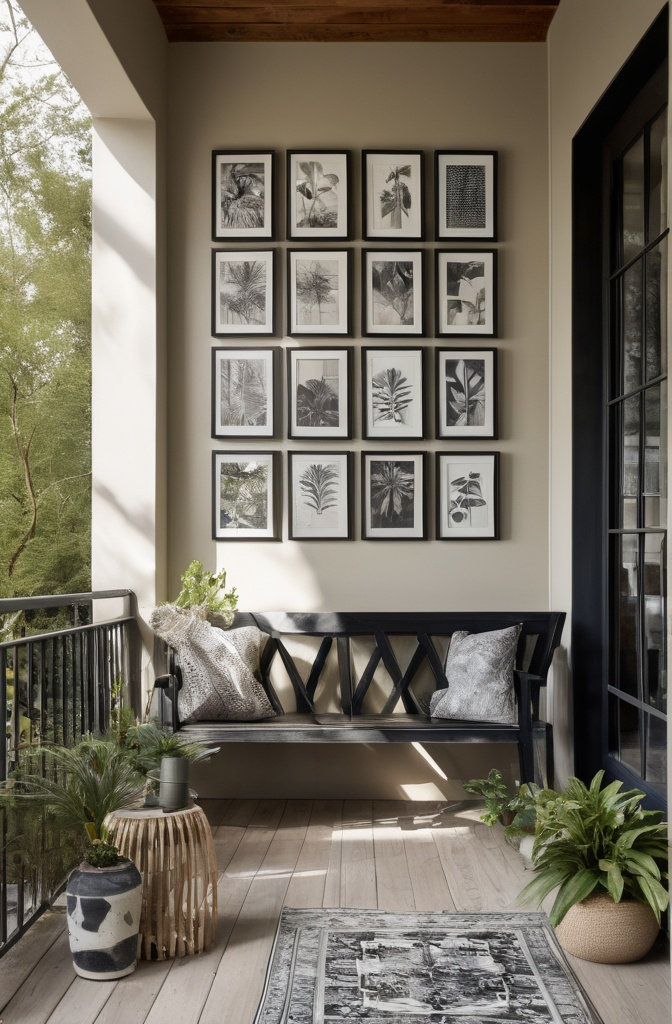
Gallery walls transform hallways from mere passageways into storytelling opportunities. Unlike other rooms where artwork might compete with furniture or views, hallways provide perfect canvas for personal expression.
“The key to a successful gallery wall is thoughtful composition,” advises curator Emma Stevens. “Rather than hanging pieces randomly, start with a ‘hero’ piece—usually your largest or most dramatic artwork—and build outward with complementary items.”
Effective gallery walls often mix:
- Framed photographs in varied sizes
- Original artwork or prints
- Three-dimensional objects like small sculptures or textiles
- Meaningful memorabilia that tells your story
To avoid a chaotic effect, maintain some consistency through either frame color, matting style, or subject matter. Designer Nick Lewis recommends, “For beginners, using identical frames in different sizes creates cohesion while allowing diverse content.”
For installation without endless wall holes, first arrange your composition on the floor, then transfer the pattern to craft paper cut to shape. Tape the paper template to your wall, mark nail positions, then remove the template before hanging your actual pieces. This method ensures perfect placement on the first attempt.
6. Built-In Storage Solutions That Disappear

Custom storage transforms problematic hallways into functional marvels. Architect Dana Wilson notes, “The most successful hallway storage solutions don’t look like storage at all—they become architectural elements in their own right.”
For narrow spaces, consider:
- Floor-to-ceiling cabinetry just 12 inches deep
- Recessed shelving between wall studs for display or small items
- Under-stair solutions that maximize otherwise wasted square footage
Material selection dramatically impacts both durability and style. In high-use areas, solid wood withstands bumps better than particleboard alternatives, though modern composite materials can offer impressive resilience at lower price points.
Case Study: The Morgans’ Victorian rowhouse featured a narrow 4-foot wide hallway with 10-foot ceilings. By installing custom built-ins along one wall—just 10 inches deep but stretching full-height—they gained storage equivalent to a full closet without compromising walkway space. Painted the same color as their walls, these cabinets virtually disappear while holding seasonal items, guest supplies, and everyday essentials.
Read This Blog: https://hometranquil.com/modern-entryway-ideas/
7. Transformative Artwork Selection
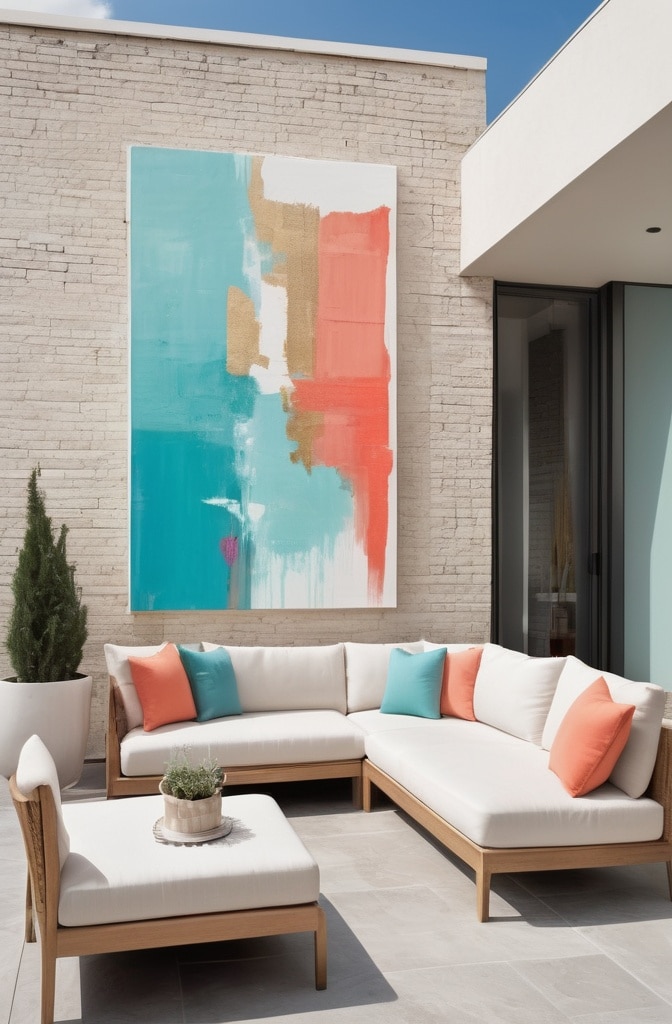
Artwork in hallways works differently than in other spaces—it’s typically viewed in passing rather than contemplated at length. This creates unique opportunities for impact and surprise.
“Scale is critical in hallway art selection,” says gallery owner Marcus Reid. “Many homeowners choose pieces too small for their walls, creating a timid effect. For maximum impact, go larger than you initially think appropriate.”
For narrow passages, consider:
- One oversized statement piece that creates a focal point
- A series of related works that draw the eye forward
- Sculptural pieces that add dimensional interest without protruding too far into walkways
Rather than generic mass-produced prints, hallways offer perfect opportunities to support meaningful work. Interior stylist Lena Park suggests, “Invest in pieces from local artists or vintage finds with history—these conversations starters immediately distinguish your home from cookie-cutter interiors.”
Proper lighting makes all the difference for artwork display. Picture lights mounted above significant pieces not only highlight your investment but add ambient illumination to the entire space. For contemporary installations, recessed adjustable spotlights offer similar benefits with cleaner lines.
8. Multi-Functional Storage That Enhances Design
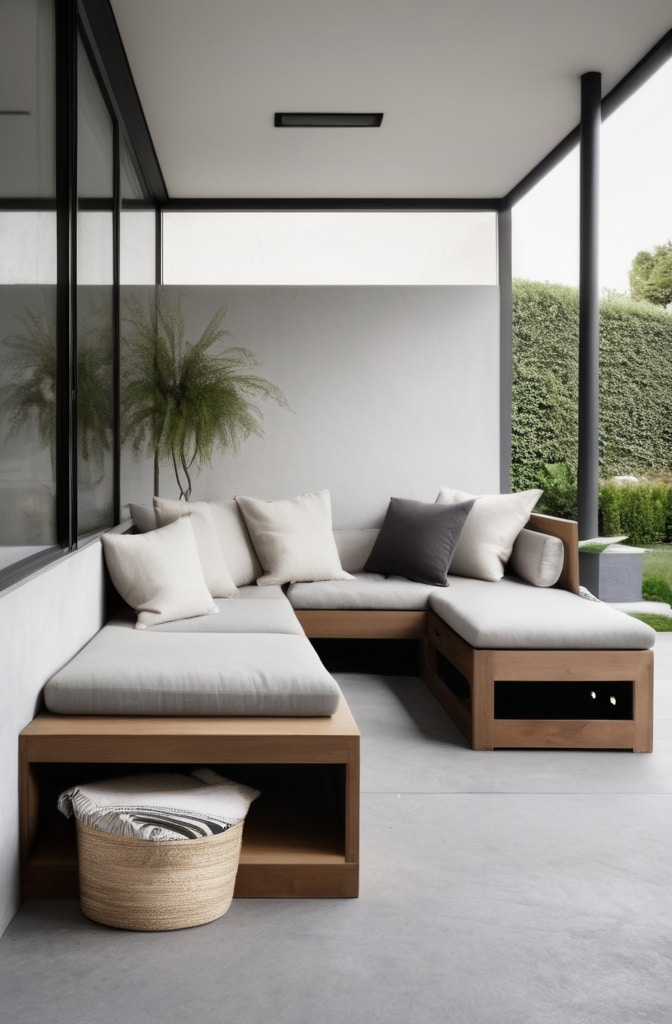
In well-designed hallways, every storage element pulls double duty—organizing essentials while contributing to the overall aesthetic. “The goal is for functionality to become invisible,” explains organization expert Marie Jensen. “When closed, storage should enhance your design scheme rather than announcing itself as purely practical.”
Innovative solutions include:
- Bench seating with hidden compartments for shoes
- Console tables with charging stations concealed in drawers
- Wall-mounted cabinets that double as display surfaces
- Floating shelves that provide both storage and visual interest
For family homes, consider creating personalized stations. Designer Anna Kotowicz suggests, “Assign each family member a dedicated hook, basket, and shelf space. This simple system prevents entrance clutter and makes mornings smoother for everyone.”
Many homeowners find seasonal rotation systems essential for hallway storage. Summer essentials like sunscreen and sunglasses replace winter scarves and gloves, keeping only current needs accessible while maintaining a streamlined appearance.
9. Accent Wall Techniques Beyond Paint
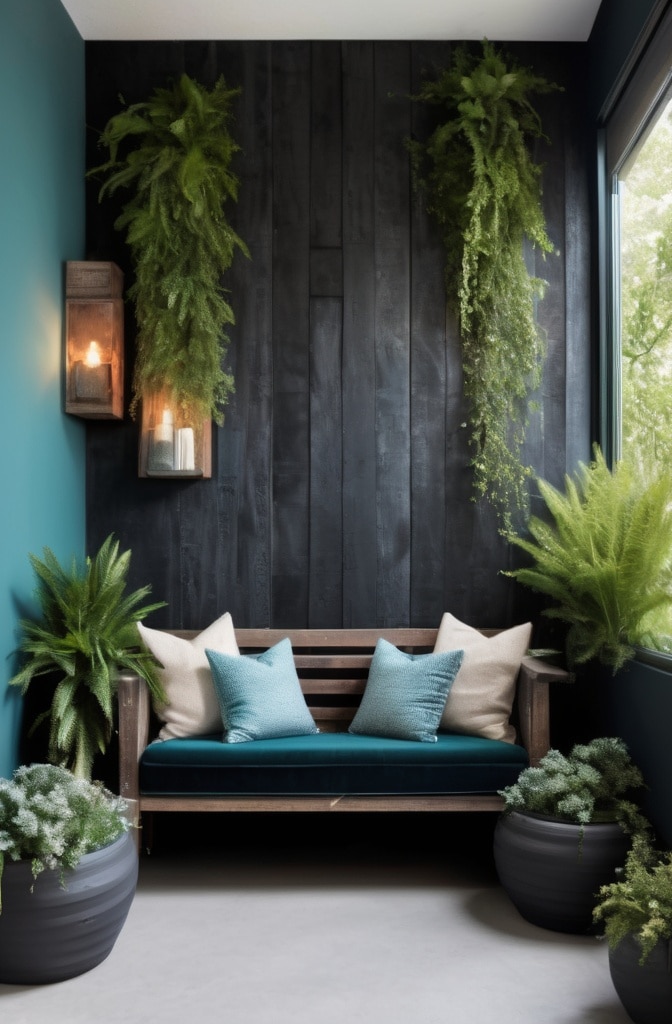
While painted accent walls remain popular, innovative textural treatments add dimension impossible to achieve with color alone. “Texture in hallways creates interest even in passing,” notes interior designer Rafael Novak. “It rewards closer inspection while adding character to otherwise simple spaces.”
Contemporary options include:
- Wood slat walls (vertical for height, horizontal for width)
- Textured wallpapers with subtle patterns
- Applied molding in geometric designs
- 3D wall panels in plaster, wood, or composite materials
For budget-conscious homeowners, DIY approaches yield impressive results. Using basic lumber, homeowner Sarah Collins created a striking slat wall for under $200 that transformed her basic builder-grade hallway into a custom-look space featured in several design magazines.
In challenging spaces, textural elements correct architectural shortcomings. Low ceilings benefit from vertical treatments that draw the eye upward, while long narrow corridors gain interest from rhythmic applications that break up expanses of wall.
10. Wallpaper as an Architectural Element
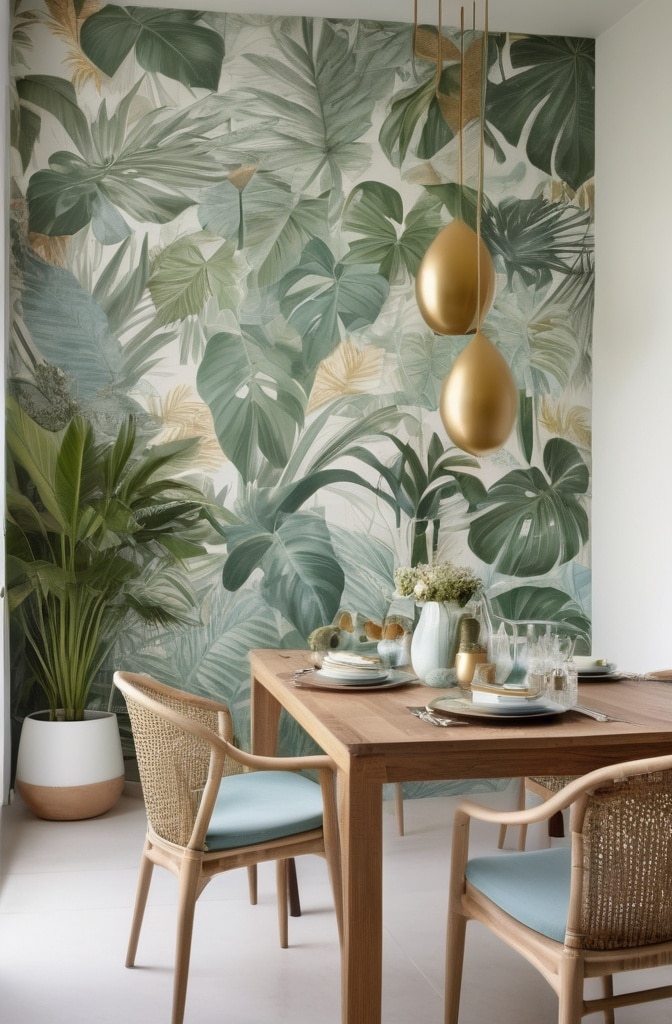
Once considered dated, wallpaper has resurged as a powerful design tool, especially in hallways where its transformative impact justifies the investment. “Hallways are perfect for statement wallpapers you might find too overwhelming in living spaces,” explains designer Grace Kim. “With limited furnishings to compete with the pattern, the paper becomes the star.”
Pattern scale significantly impacts spatial perception:
- Large-scale patterns work surprisingly well in small spaces, creating depth and interest
- Small, repetitive patterns add texture without overwhelming narrow passages
- Vertical patterns draw the eye upward, making ceilings appear higher
Today’s removable wallpapers offer particular advantages for renters or design enthusiasts who enjoy frequent changes. These peel-and-stick options install and remove without damage, allowing hallway transformations without commitment.
For maximum architectural impact, consider combining wallpaper with millwork. “Applying wallpaper above chair rail molding while keeping lower portions painted creates a balanced, classic look,” suggests design historian Peter Hughes. “This technique dates back centuries but looks remarkably fresh in contemporary applications.”
11. Strategic Plant Placement for Life and Air Quality
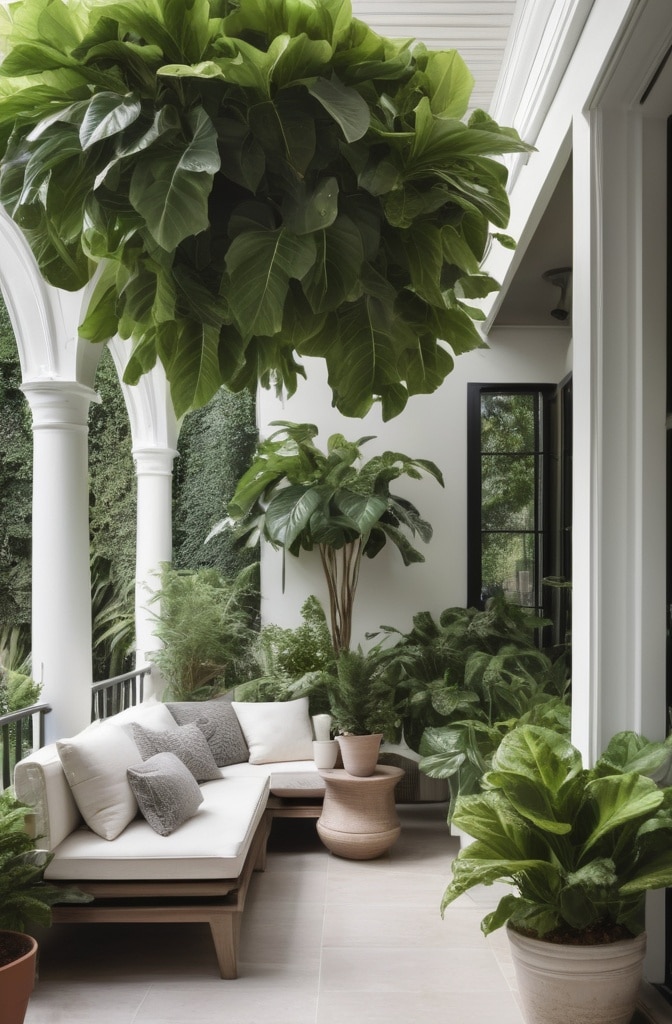
Plants contribute more than aesthetic value to hallways—they improve air quality while bringing natural elements indoors. The challenge lies in selecting varieties that thrive in typical hallway conditions.
“Most hallways have limited natural light, making plant selection crucial,” explains botanist and interior plant specialist Dr. Maya Rivera. “Focus on varieties known for air-purifying properties that tolerate lower light levels.”
Ideal hallway plants include:
- Snake plants (Sansevieria) – virtually indestructible and excellent air purifiers
- ZZ plants (Zamioculcas zamiifolia) – glossy, architectural and drought-tolerant
- Pothos varieties – trailing vines perfect for elevated shelves
- Cast iron plants (Aspidistra elatior) – Victorian favorites that withstand neglect
For narrow spaces, vertical gardens maximize impact without consuming precious floor space. Wall-mounted systems range from high-tech self-watering installations to simple shelving arrangements with cascading plants.
According to NASA research, certain houseplants remove significant amounts of common indoor pollutants. In hallways connecting to exterior doors, these natural air purifiers create healthier transitions between outdoor and indoor environments.
12. Flooring Solutions for Heavy Traffic Areas
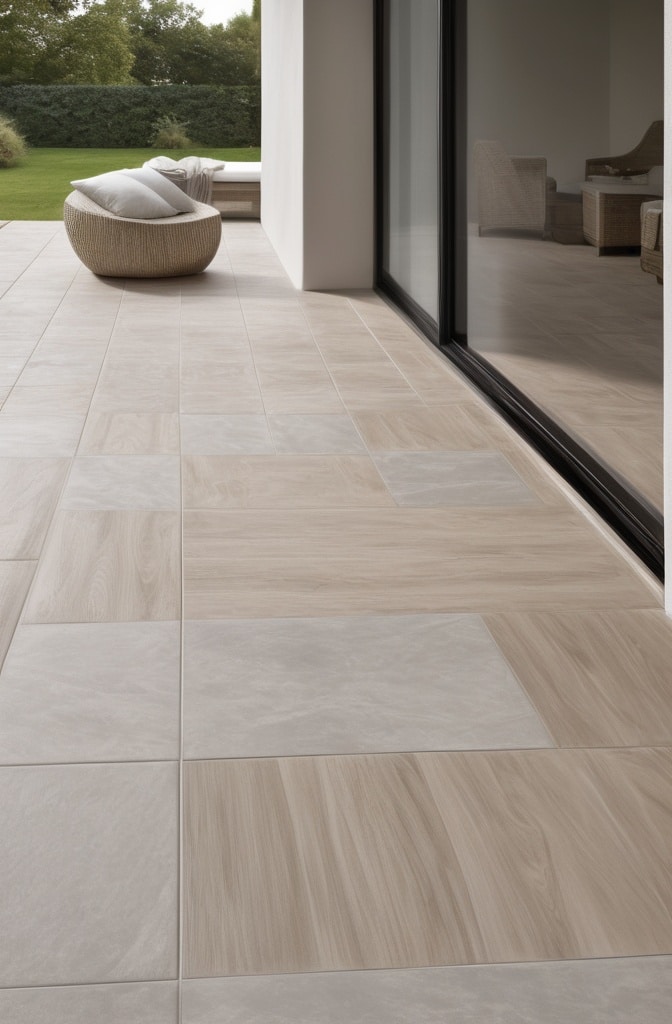
Hallway flooring endures more abuse than almost any other surface in the home, requiring materials that balance durability with style. “The average hallway sees 15-20 crossings daily per household member,” notes flooring expert Daniel Murphy. “That’s thousands of footsteps annually demanding surfaces that resist wear patterns.”
Comparative testing reveals clear durability winners:
- Porcelain tile (rated 9/10 for durability) – virtually indestructible
- Luxury vinyl plank (8.5/10) – water-resistant and forgiving underfoot
- Engineered hardwood (7.5/10) – balances warmth with reasonable durability
- Traditional hardwood (6.5/10) – beautiful but shows wear paths over time
Beyond durability, sound considerations significantly impact hallway comfort. “Hard surfaces amplify footsteps, especially in multi-story homes,” explains acoustic consultant Jana Wilson. “Consider underlayments with sound-dampening properties or incorporate runners and rugs to absorb noise.”
Transitions between spaces deserve particular attention. Designer Thomas Reed suggests, “When possible, continue the same flooring from hallways into adjoining rooms for visual flow. Where changes are necessary, ensure transition strips are secure and as low-profile as possible to prevent tripping hazards.”
13. Console Tables: The Anchor of Functional Hallways
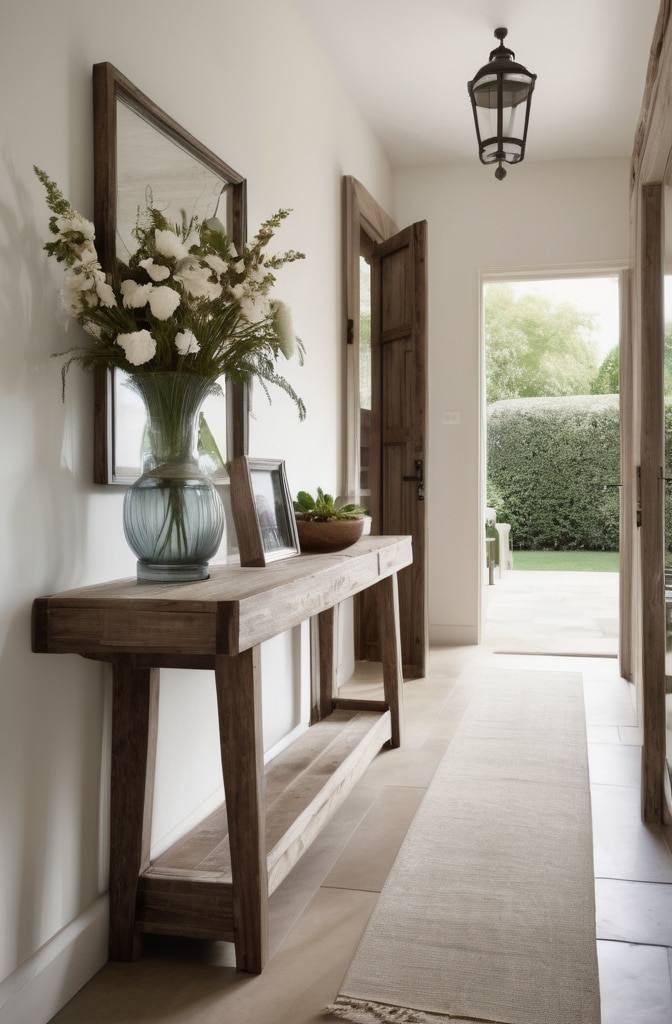
The hallway console table functions as command central—a hardworking piece that defines the entry experience. “For maximum functionality without overwhelming the space, aim for tables between 30-36 inches high with depth between 12-15 inches,” recommends furniture designer Elena Sorokina.
When selecting console tables, consider:
- Proportion relative to hallway width (ideally occupying no more than one-third of available width)
- Storage needs (drawers vs. open shelving)
- Material durability in high-traffic settings
- Style compatibility with your overall aesthetic
For styling, interior decorator Phillip James suggests the “rule of threes” approach: “Group objects in odd numbers, varying heights and textures while maintaining a cohesive color story.” This creates visual interest without cluttered appearance.
Multi-functional features worth investing in include:
- Built-in charging stations for devices
- Hidden drawers for keys and everyday essentials
- Lower shelves for baskets containing seasonal items
- Mirror attachments for last-minute appearance checks
For extremely narrow hallways, consider wall-mounted console alternatives that provide surface area without base footprints. These floating designs can be custom-sized to exact space requirements while maintaining visual lightness.
14. Hidden Storage Innovations
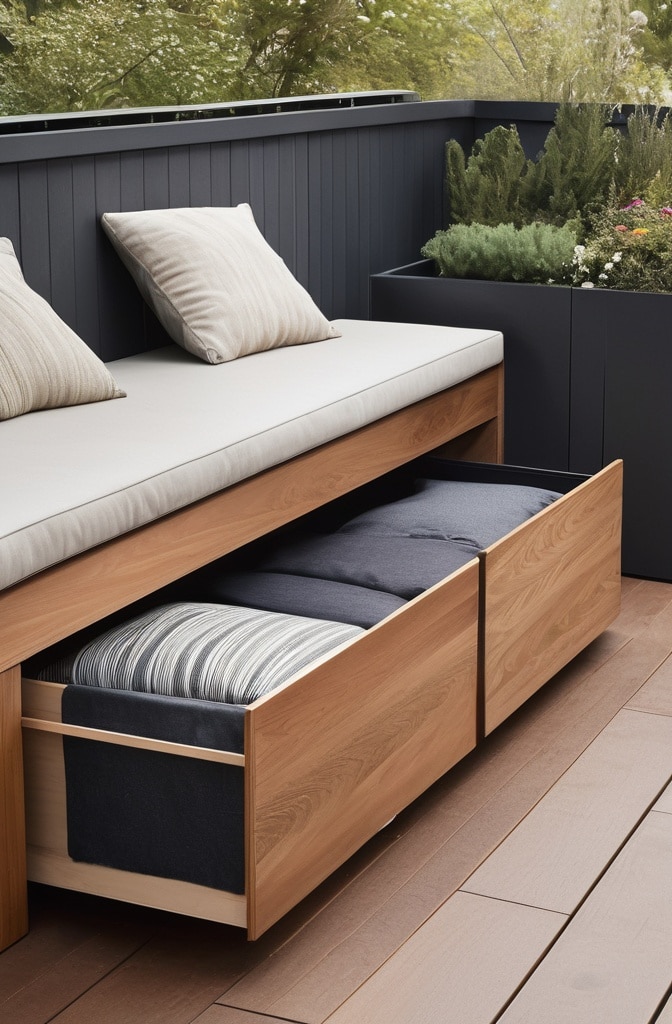
Truly ingenious hallway design incorporates storage in unexpected places. “I approach hallways as storage puzzles,” explains organization specialist David Chen. “Every vertical surface, corner, and transition point offers potential for hidden functionality.”
Under-stair areas represent particular opportunities, ranging from:
- Pull-out drawer systems customized to the angle of stairs
- Cabinet installations with specialized interior fittings
- Open cubbies for daily-use items
- Bench seating with internal compartments
Wall cavity installations maximize space efficiency without protruding into walkways. By recessing storage between studs, homeowners gain 3-4 inches of depth—sufficient for medicine cabinet-style solutions holding smaller items.
Technology integration elevates modern hallway storage. “Creating dedicated charging zones within cabinetry keeps devices accessible but visual clutter contained,” notes smart home designer Marcus Liu. “Consider built-in USB ports and cable management systems for seamless functionality.”
For growing families, adaptable systems prove most successful. Height-adjustable hooks, reconfigurable cubbies, and modular components evolve as children grow from toddlerhood through teen years without requiring complete replacement.
15. Lighting Design Strategies Beyond Fixtures
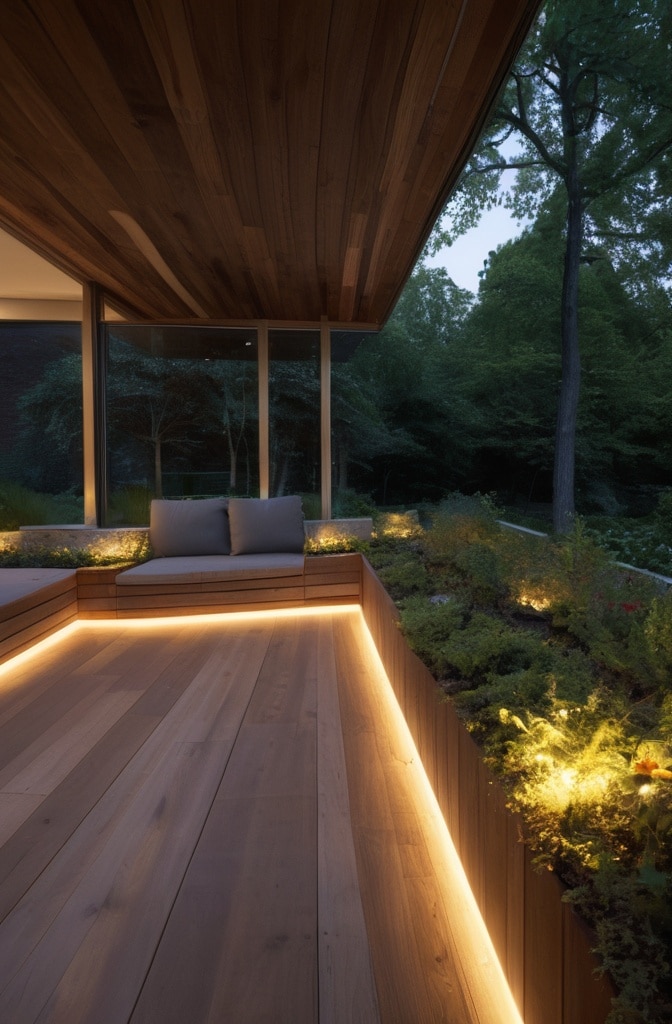
Sophisticated hallway lighting transcends basic fixtures to create layered experiences. “Think beyond simple illumination to creating rhythm through light and shadow,” suggests architectural lighting designer Sophia Mendez. “Hallways offer perfect opportunities for lighting as art.”
Creating visual rhythm involves:
- Equally spaced wall sconces establishing pattern and movement
- Wash lighting highlighting textural elements like brick or paneling
- Focused spotlights drawing attention to artwork or architectural features
- Floor-level lighting providing subtle wayfinding without harshness
Energy efficiency needn’t compromise design impact. LED technology offers unprecedented control while reducing consumption by up to 80% compared to traditional incandescent solutions. Smart systems further optimize by adjusting output based on time of day or occupancy detection.
Seasonal adaptation transforms hallways throughout the year. “Program lighting scenes for different occasions and seasons,” recommends home automation specialist Kevin Park. “Brighter, energetic morning settings can transition to warmer, softer evening ambiance automatically, creating responsive environments that enhance daily living.”
16. Vertical Design Elements That Draw the Eye Up
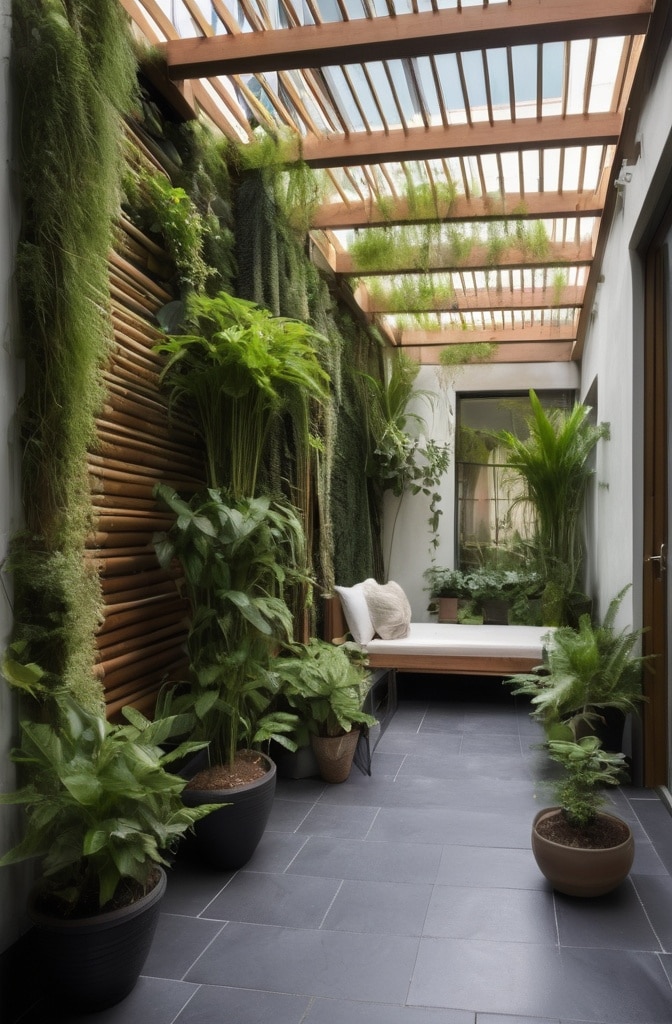
Vertical thinking transforms hallway design, particularly in spaces with challenging proportions. “People typically focus at eye level, missing opportunities above and below,” explains spatial designer Olivia Chan. “By intentionally drawing gazes upward, even modest hallways gain perceived volume.”
Effective vertical elements include:
- Floor-to-ceiling bookcases or display shelving
- Tall, narrow artwork installations
- Pendant lights with elongated forms
- Architectural details like applied molding or ceiling medallions
Ceiling treatments deserve particular attention in hallway design. “Ceilings represent large, uninterrupted surfaces typically ignored,” notes interior architect Benjamin Ross. Options range from simple paint colors contrasting with walls to more elaborate applications like wallpaper, coffered details, or applied molding patterns.
For narrow hallways specifically, vertical storage must balance function with proportion. “Keep protruding elements under 12 inches deep,” advises spatial planner Naomi Wright. “Beyond this depth, narrow passages begin feeling constricted regardless of ceiling height.”
17. Door Transformations with Dramatic Impact
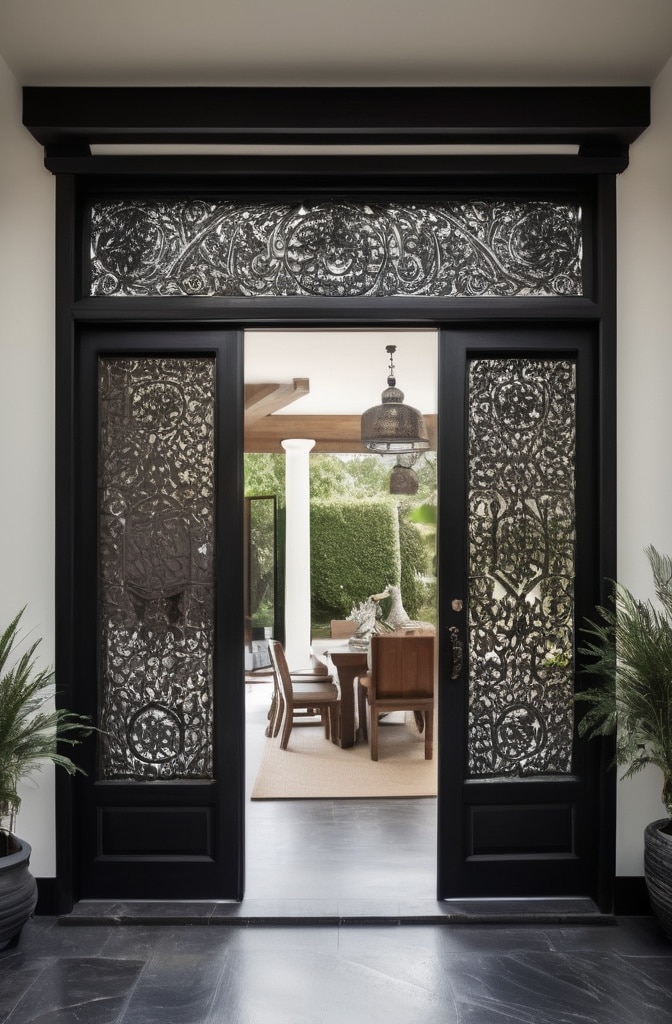
Doors constitute significant visual real estate in hallways yet often receive minimal design attention. “Upgrading doors delivers remarkable impact relative to investment,” notes renovation specialist Thomas Burton. “It’s among the highest ROI projects for hallway transformations.”
Beyond simple color changes, consider:
- Applied molding creating paneled effects on flat doors
- Replacing solid panels with frosted or reeded glass inserts
- Hardware upgrades from basic knobs to architectural handles
- Specialized treatments like wallpaper application or decorative painting
Space-saving alternatives dramatically improve hallway functionality. Pocket doors reclaim nearly 10 square feet of swing space, while barn-style sliding installations add architectural character. French doors between hallways and adjoining rooms allow light flow while maintaining separation capability when desired.
Security and privacy needn’t compromise aesthetics. “Today’s high-security locks come in designer finishes and streamlined profiles,” explains security consultant Rebecca Johnson. “Similarly, sound-dampening door construction maintains privacy without institutional appearance.”
18. Seating Areas That Welcome and Serve
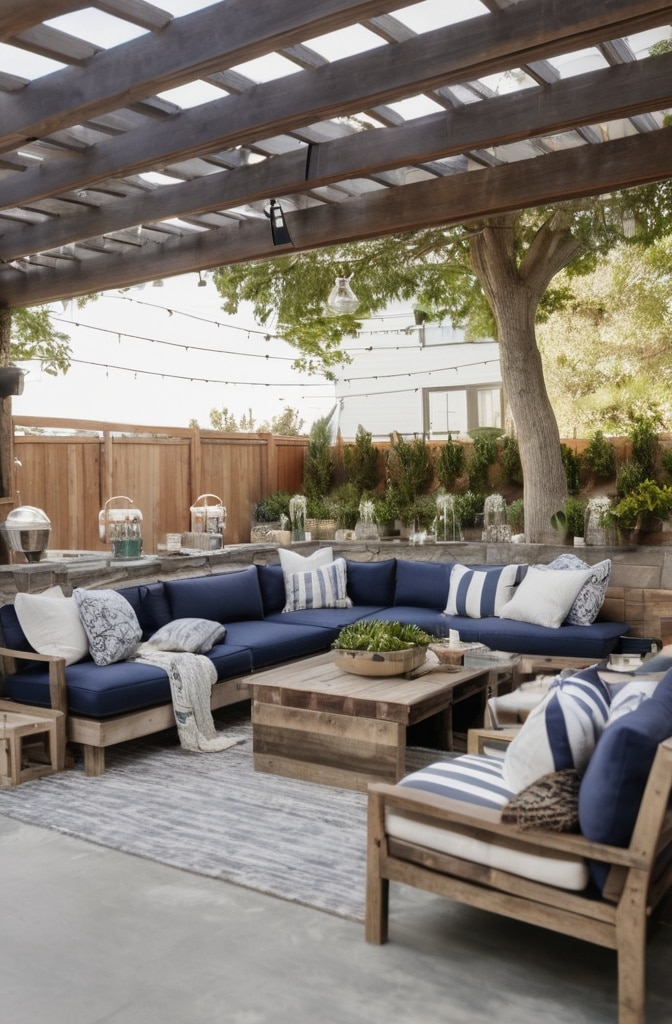
Even minimal hallways benefit from thoughtfully integrated seating. “Having a place to sit while removing shoes or setting down bags transforms the entry experience,” notes ergonomics specialist Dr. Andrew Mitchell. “It signals hospitality while serving practical functions.”
Right-sized options include:
- Slim benches requiring just 18 inches of depth
- Built-in window seats in hallways with exterior walls
- Ottomans that double as occasional tables or storage
- Fold-down seating that disappears when not needed
For maximal functionality, integrate companion elements. Designer Isabel Torres recommends, “Pair seating with hooks at appropriate heights, shelving for bags, and if possible, mirror placement for quick appearance checks. This creates a complete arrival/departure zone streamlining daily transitions.”
In larger hallways, consider creating defined conversation areas. “A small bench or pair of chairs with a compact side table transforms transitional space into a usable pocket for brief interactions or quiet moments,” suggests social space planner Marcus Wei. “These micro-lounges add significant value to otherwise purely functional areas.”
19. Vintage and Antique Integration Strategies
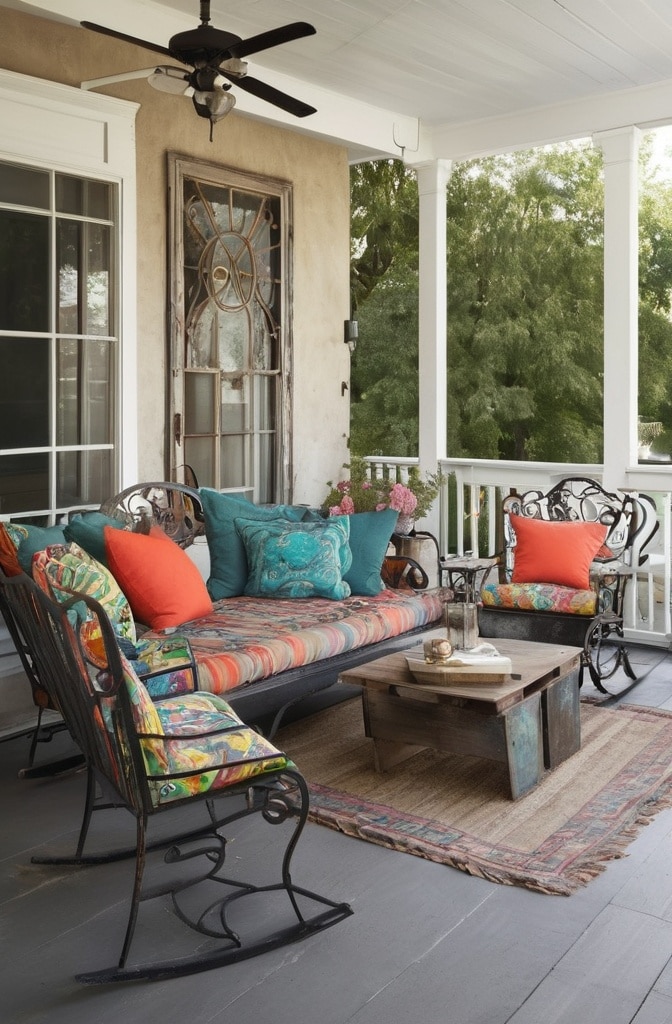
Heritage pieces add soul to hallways through their inherent character and history. “Vintage elements connect spaces to broader traditions and narratives,” explains design historian Katherine Bell. “They add instant depth impossible to achieve with entirely contemporary schemes.”
Effective focal points include:
- Antique console tables adapting gracefully to narrow footprints
- Vintage mirrors with patina and character
- Heritage lighting fixtures as sculptural elements
- Repurposed architectural salvage like corbels or newel posts
Balancing old with new prevents museum-like stiffness. Interior stylist James Peterson suggests the “70/30 rule”—roughly 70% contemporary elements with 30% vintage creates tension and interest without overwhelming the space with competing period references.
Adaptation maintains functionality while honoring character. “Don’t hesitate to modify vintage pieces for contemporary needs,” advises furniture restorer Elena Mikhailova. “Adding discreet charging ports to antique consoles or reinforcing joinery for modern use preserves relevance without compromising integrity.”
20. Open Display Solutions for Personal Collections
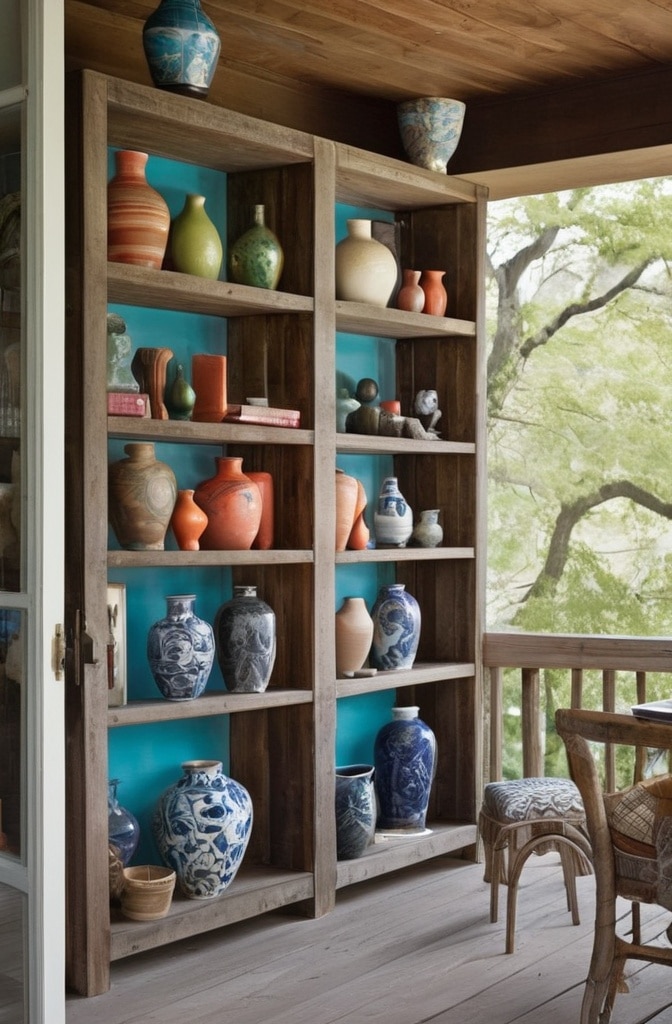
Curated displays transform hallways from generic passages to deeply personal spaces. “Collections tell your story without words,” notes cultural anthropologist Dr. Mirai Tanaka. “Hallway displays create conversations and connections uniquely suited to transitional spaces.”
Successful display strategies include:
- Unified collections with variations on a theme (vintage cameras, ceramic vessels, travel mementos)
- Rhythmic arrangements emphasizing similarity and difference
- Negative space allowing objects to “breathe” rather than crowd
- Consistent background treatment unifying diverse elements
Rotation systems maintain fresh interest while accommodating larger collections. Designer Wei Chen recommends, “Create a ‘library’ of display objects in accessible storage, rotating selections quarterly. This approach protects items from dust while creating seasonal refresh opportunities.”
For valuable or fragile items in high-traffic areas, protective considerations become essential. Museum-quality UV-filtering acrylic boxes protect without visual obstruction, while strategic placement above typical bumping height prevents accidental damage.
Conclusion: Principles for Successful Hallway Design
The most successful hallway transformations share fundamental characteristics regardless of specific style choices. They balance aesthetic appeal with everyday functionality, creating spaces that enhance rather than merely connect.
Key principles include:
- Respecting architectural realities while maximizing potential
- Layering elements for depth and interest
- Ensuring sufficient storage to maintain order
- Creating lighting that adapts to different needs
- Expressing personality through thoughtful details
For immediate impact without major investment, focus first on:
- Decluttering existing spaces
- Upgrading lighting for better quality illumination
- Adding a statement mirror for light amplification
- Introducing a washable runner for color and texture
- Creating simple wall displays with items you already own
Remember that hallways evolve alongside your home. Interior designer Grace Thompson notes, “The most successful hallways I’ve designed embrace change—seasonal rotations keep entrances fresh while fundamental elements provide continuity.”
Rather than viewing hallways as challenges, recognize their unique potential as spaces expressing welcome, transition, and personality. With thoughtful application of these principles, even the most modest entrance can become an exceptional introduction to your home.
Additional Resources
For deeper exploration of hallway transformation strategies:
Designer Insights:
- Interview with Nina Campbell on transitional spaces: Architectural Digest
- Small Space Solutions from Sarah Richardson: HGTV Design
Planning Tools:
- Free printable hallway measurement worksheet: Interior Planning Association
- Seasonal refresh checklist for entryways: Home Style Guide
Material Resources:
- Durable flooring comparisons for high-traffic areas: Consumer Reports
- Space-saving hardware solutions: Build.com
